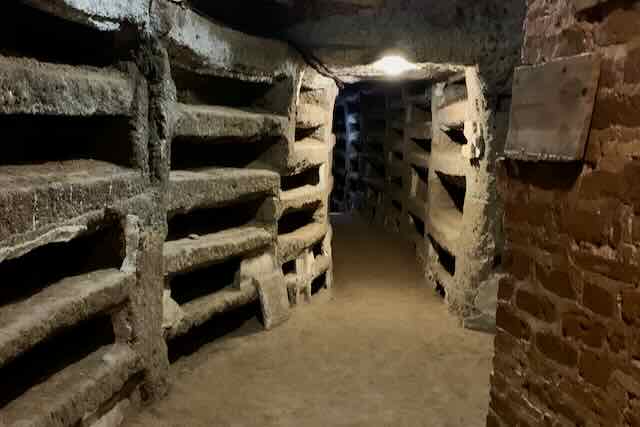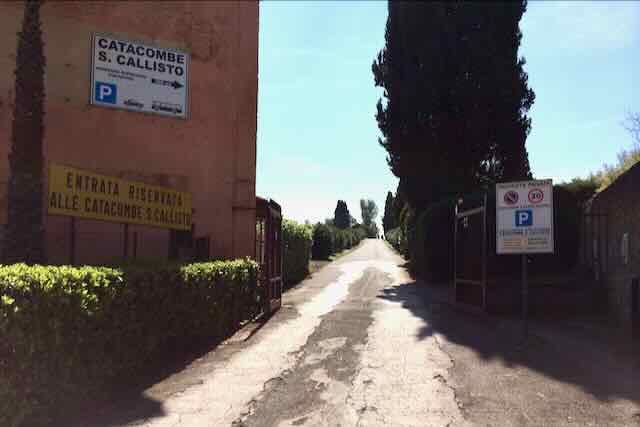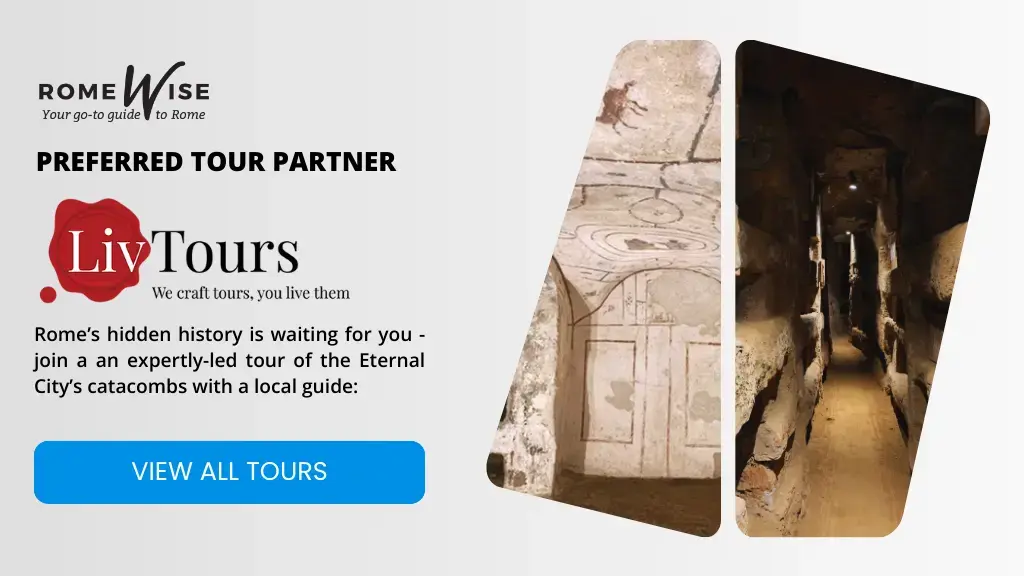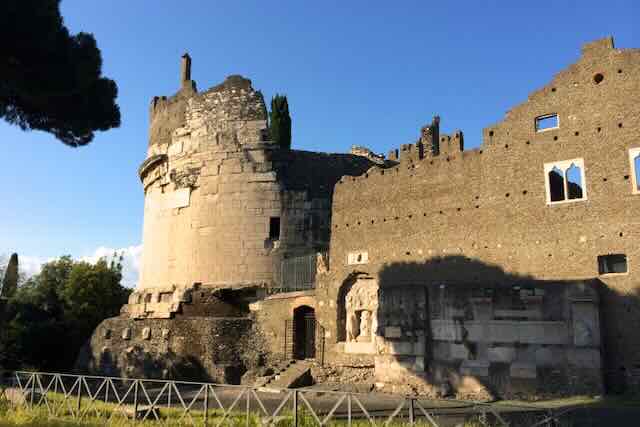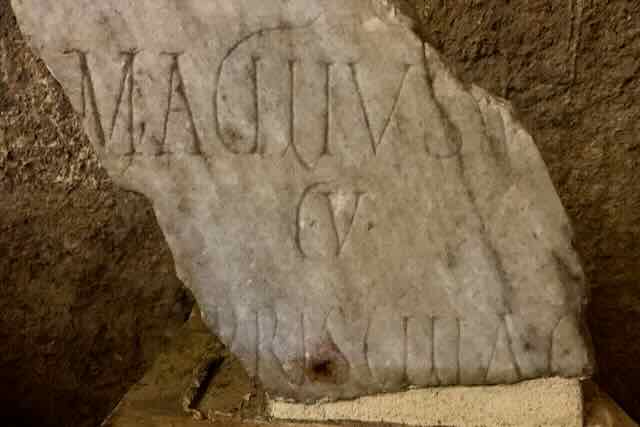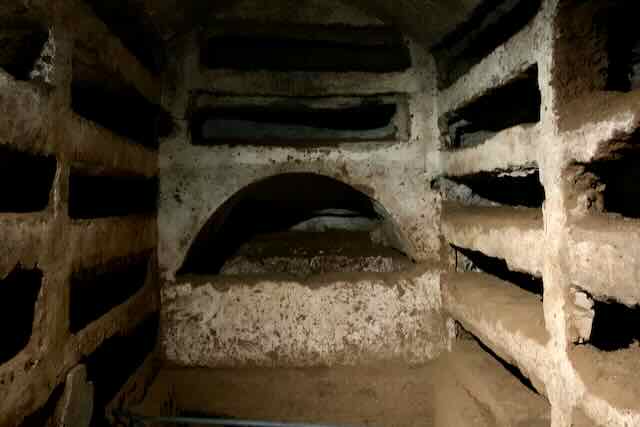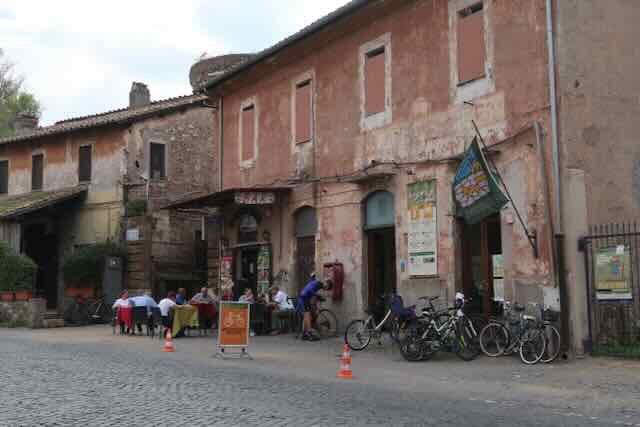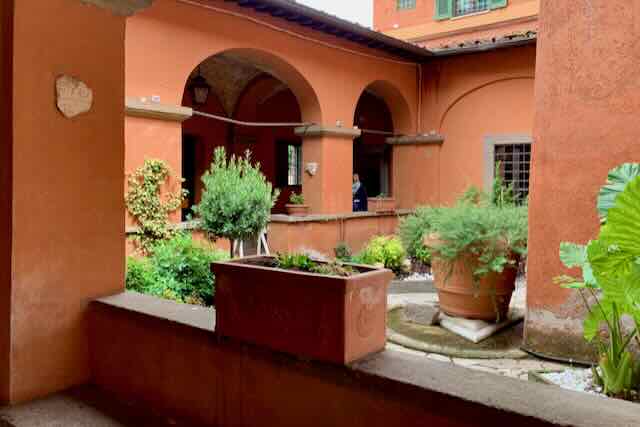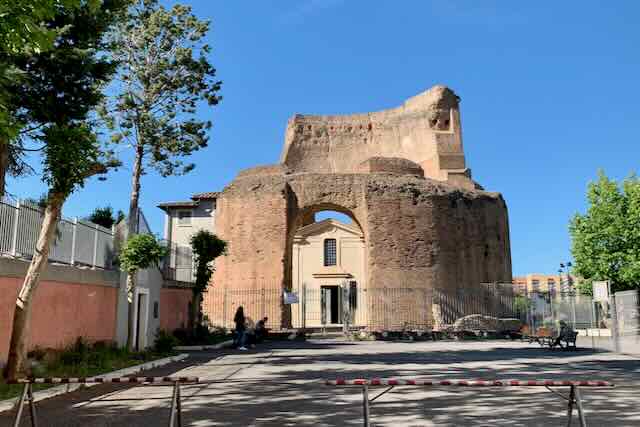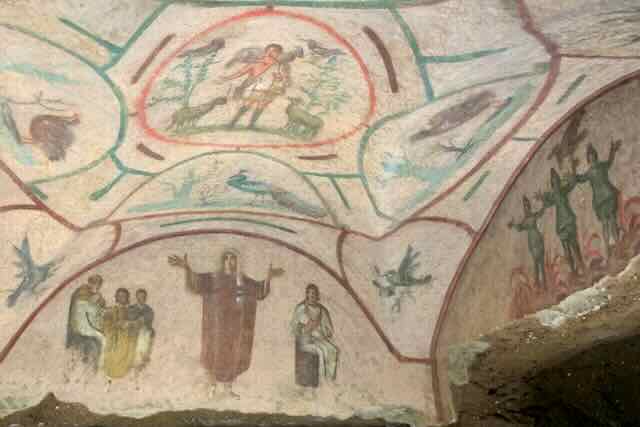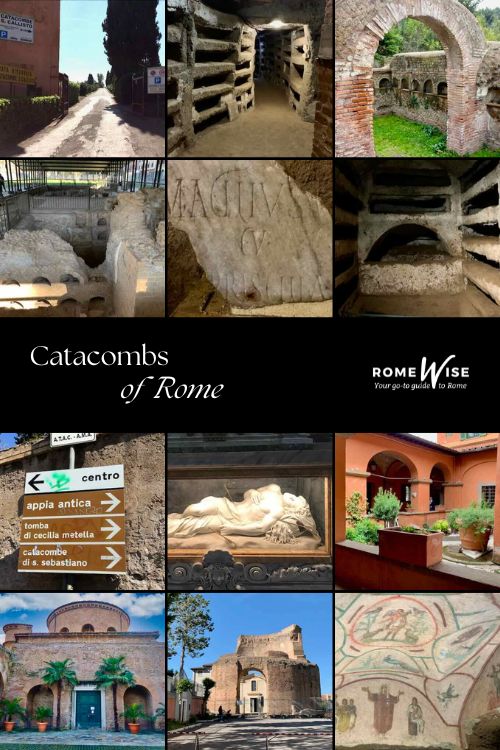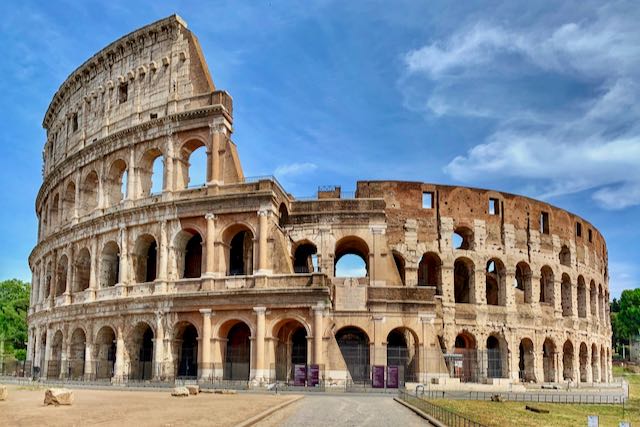- Sign up & get a FREE ebook Subscribe NOW!
- Romewise Home Page
- What to Do in Rome
- Romantic Things to Do in Rome
- catacombs of Rome
Everything You Need To Know Before Visiting The Catacombs Of Rome
Thinking of visiting the catacombs of Rome?
Wondering if it's worth it?
Catacombs of Rome - Everything You Need to Know
If you love Ancient Roman history, art, and off-the-beaten-path sightseeing, add the catacombs to your Rome itinerary!
On this page, we'll go over:
- A brief history of the catacombs of Rome - what are they, when were they built, and what were they used for?
- What is the Christian history of the Roman catacombs?
- Where are the Rome catacombs?
- How can you visit the different catacombs of Rome?
- What will you see when you visit Rome's catacombs? Are there bones?
- Is it worth seeing the Rome catacombs?
So read on for some fascinating Roman catacombs facts!
History of the Catacombs of Rome
What are the catacombs?
So whats a catacomb?
The catacombs of Rome are a network of underground burial chambers located around the city of Rome.
There are probably 50-60 catacombs underground Rome, but only a handful have been excavated and only 6 are open regularly.
The catacombs began being used as burial sites for centuries, starting in the 2nd century CE.
They were used by people of varying faiths - Christian, Jewish, and pagan, but fell out of use around the 5th century.
In the 9th century, Rome was often vandalized by Germanic tribes from the north, and many catacombs were plundered for their valuables.
As a result, popes began moving Christian martyrs and saints remains and relics to churches in Rome where they can be found today.
The popes then blocked the entrances and they were forgotten for over 500 years.
In 1578, Maltese-born archaeologist, Antonio Bosio (1576 – 1629 CE), stumbled upon an entryway to a catacomb along the Via Salaria.
In 1593, he rediscovered the Catacombs of Domitilla, nearly getting lost in the labyrinth as he delved further in.
Nick-named “Columbus of the Catacombs” because he was the first to systematically explore and document the Roman catacombs, Bosio published Roma Sotterranea, which became an essential guide to future archeologists and those studying the catacombs.
When and how were the catacombs of Rome built? Who built them?
From the earliest days of the Roman Republic (6th century BCE), it was forbidden to bury the dead inside city walls.
This was likely to prevent the spread of disease, but also to prevent overcrowding in rapidly growing cities.
This law was later observed across the Roman Empire, which is why you find ancient necropolises, or "cities of the dead", also at Pompeii, Ostia Antica, etc.
(Many of these are above-ground.)
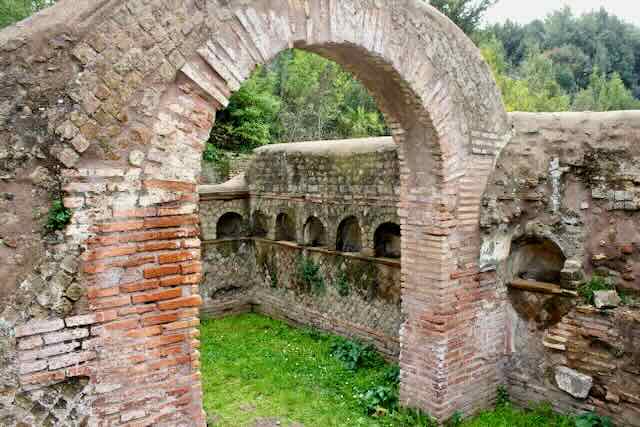 Examples of Catacombs Italy - When visiting Ostia Antica and the ruins of other ancient Roman towns you'll frequently see these necropolises, but always outside the old city walls.
Examples of Catacombs Italy - When visiting Ostia Antica and the ruins of other ancient Roman towns you'll frequently see these necropolises, but always outside the old city walls.Before Christianity became popular, Ancient Romans cremated their dead and placed them in urns which in turn were placed in honeycomb-like structures called a colombario.
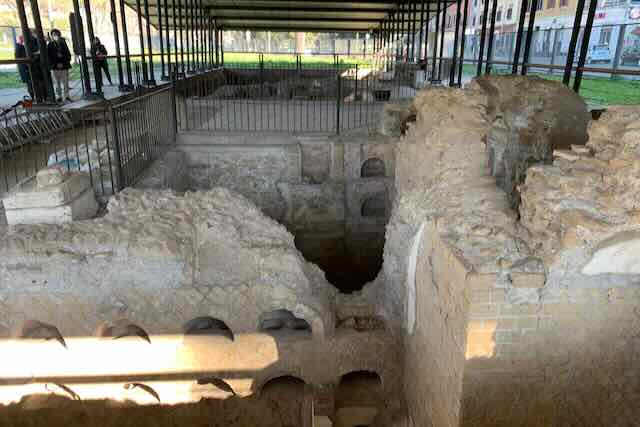 At this small display of Ancient Roman ruins near the basilica of St Paul Outside the Walls you can see the classic colombario structures where people's ashes were kept
At this small display of Ancient Roman ruins near the basilica of St Paul Outside the Walls you can see the classic colombario structures where people's ashes were keptChristians and Jews did not want to be cremated, preferring "inhumation", which kept the body intact.
The earliest underground tunnels near Rome were dug by the Etruscans and primitive Romans, who were looking for minerals and other useful underground substances such as sandstone and limestone.
These tunnels were dug out of the soft earth we have around Rome, called "tuff" or tufo in Italian.
As the idea to bury people in inexpensive mass graves outside the city limits began to take hold, these same underground tunnels were repurposed as catacombs.
This began in around the 1st century, making them the oldest catacombs ever built.
The wealthy sometimes built impressive tombs for themselves and their families above ground, and you can see some of these if you visit the Appia Antica.
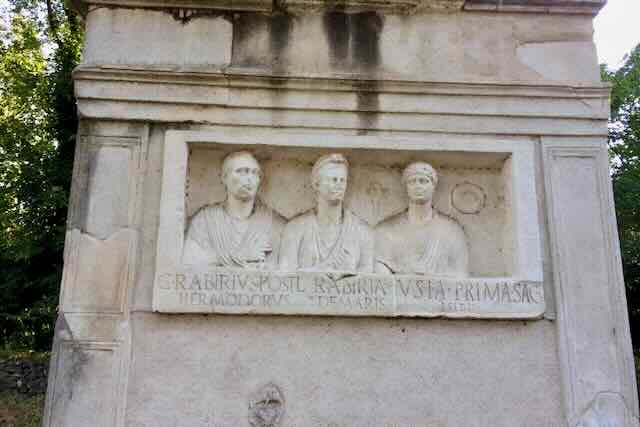 When walking along the ancient Appian Way which leads out of the city, you'll see many funerary monuments like this one
When walking along the ancient Appian Way which leads out of the city, you'll see many funerary monuments like this oneOne of the largest and most famous of these is the tomb of Cecilia Metella, a 1st century BCE tomb of a daughter of a Roman Consul.
But the tunnels were a convenient way to bury a lot of people in a relatively safe way, far from the city limits.
The bodies were usually wrapped in 2 layers of linen, sprinkled with lime to help mask the smell, and placed in loculi, or small niches cut into the walls of the tunnels.
When you visit the catacombs, you will also notice smaller loculi for children.
The catacombs were built over the course of several centuries, with the majority built during the 3rd and 4th centuries CE.
What were the catacombs of Rome used for?
The Rome catacombs were used as a place to bury the dead.
This included people of all faiths, Christian, Jewish, and pagan.
The word "cemetery" derives from the Greek word for "sleeping place", and this is exactly what the catacombs were - a place for the dead to rest.
The word "catacomb" also derives from Ancient Greek. "Kata" meant "near" and "kymbas" meant "cave".
This in turn became the Latin "cata cumbas", in English catacombs meaning "among the graves".
Contrary to popular belief, they were likely not used as a place for Christians to meet in secret to avoid persecution.
Ready to plan your trip?
Book your train
Planning to travel between cities in Italy and other parts of Europe?
Use Trainline to see all the different options available across the different rail companies.
Find your hotel
Find your perfect place to stay in Rome.
Use Booking.com to choose between hotels, guesthouses, and self-catering apartments in neighborhoods throughout the Eternal City.
Buy your TurboPass
Purchase the convenient Turbopass and visit all of Rome's top attractions including the Colosseum, Pantheon, and Vatican.
With one handy pass, it's all included.
How many people were buried in the catacombs of Rome?
As the tunnels go for miles and miles (much of this has not been excavated), and as the dead were often piled on top of each other, thousands upon thousands of people were buried in the Roman catacombs.
Are there still bodies in the catacombs of Rome?
There are no longer any visible bodies buried in the catacombs of Rome. The catacombs are now mostly empty.
Some of the bodies that were once buried there have been moved to other burial sites, and in many cases, the remains have simply disintegrated over time.
How long are the Rome catacombs?
There are several catacombs around Rome, and some of them have not even been excavated yet.
But of those that have been, there are miles and miles of them.
One could easily get lost in there, which is one reason you must visit as part of a guided tour.
Christian History of the Roman Catacombs
What did the first Christians use the catacombs of Rome for?
Christianity began to spread through Rome in the mid-1st century CE, and by the 2nd century CE there was a large and thriving Christian community in Rome.
The catacombs were an important part of early Christian life in Rome.
They provided a place for Christians to bury their dead.
This tradition continued until around the 5th century CE.
Is it true that Christians would meet in secret because Christianity was banned?
The idea that the catacombs were used by Christians as a place to meet in secret because they were being persecuted has largely been discredited - most scholars today debunk this urban myth.
First of all, the persecution of Christians was sporadic and inconsistent, happening over long stretches of time.
Second of all, the catacomb locations were well-known, so it would be hard to hold secret meetings there.
It is more likely that when people, Christian or otherwise, met in the catacombs, it was to celebrate their dead family members.
What are the features of the Christian catacombs?
They're home to a wealth of early Christian art.
This includes examples of early Christian symbol like the Good Shepherd, as well as depictions of scenes from the Old Testament.
You will also find many examples of early Christian inscriptions or graffiti in the catacombs.
This writing often contains the names of the dead which helps us to understand who was buried there.
One of my favorite catacombs is the catacomb of Santa Priscilla.
There you can see the earliest known depiction of Mary as mother of God.
What are the cubicula?
The function of the cubicula was to provide small, private burial chambers for wealthy families, something like a family crypt.
Each cubiculum consisted of a number of small rooms that were used to bury the dead.
The rooms were often decorated with Christian symbols and inscriptions.
The catacombs also contain arched recesses called arcosolia.
The word derives from Latin arcus, "arch", and solium, "throne".
How to visit the catacombs of Rome
Which catacombs can you visit in Rome?
The catacombs you can easily visit in Rome are the catacombs of Callixtus, Sebastian, Saint Domitilla, Agnes, Priscilla, and Marcellinus and Peter.
There are a few more that you can visit only upon request, such as the catacombs of Comodilla or San Pancrazio.
There are six known Jewish catacombs in Rome.
Only two are open for visits - the tombs at Vigna Randanini and at Villa Torlonia (these are currently being restored, so as of 2022 are not open to visitors).
These catacombs, while sometimes available for visits, are not regularly open.
The only way to see them is with a guided visit upon special request.
Other examples of burial places or tombs in or near Rome you may want to visit include:
- Saint Peter's tomb
- The Capuchin Crypt (not a catacomb, but the best place to see bones if you are interested)
- The Mausoleum of Augustus and the Mausoleum of Hadrian (today Castel Sant'Angelo.)
- If you are interested in cemeteries, we have some beautiful and interesting ones in Rome.
- Etruscan tombs not far from Rome (a great day trip from Rome or shore excursion)
You can also see some Etruscan tombs in the Villa Giulia and inside the Vatican Museums' Etruscan wing.
What is the best time to visit the catacombs in Rome? What are the opening hours of the catacombs? What is the entrance fee?
All the catacombs have differing opening hours so you can almost always find one open.
Many of them have a period of closure in summer or winter.
- San Callisto: Open Thursday - Tuesday 09:00 - 12:00, 14:00 - 17:00. Closed on Wednesdays and certain holidays, check here for the latest closure dates.
- San Sebastiano: Open Tuesday - Sunday 9:15 - 17:15 (last admission 16:45). Closed on Mondays and certain holidays - check here for the details.
- Santa Domitilla: Open Wednesday - Monday 9:00 - 12:00, 14:00 - 17:00 (The last guided Rome catacombs tour begins 30 minutes before closure, both in the morning and in the afternoon). Closed on Tuesdays and other select dates - find the updated list here.
- Santa Priscilla: Open Tuesday - Sunday 09:30 - 13:00, 14:00 - 17:00. Closed on Mondays and for holidays - find the latest dates here.
- Sant'Agnese: Open Monday - Saturday 10:00 - 13:00, 15:00 - 18:00. Closed on Sundays and on mornings of religious holidays - see all the details here.
- Saints Marcellinus and Peter: Open Friday – Wednesday 10:00 - 12:00, 14:00 - 17:00. Closed on Thursdays and a summer vacation - check here for the details.
Can you visit the catacombs without a guide?
No, you must go with a guide.
You cannot buy Roman catacombs tickets and walk around on your own inside.
In some cases, you can go with a guide working for the site.
In many cases, you can book a tour with a tour company.
This can be convenient because with a tour company you can usually see more than one site, and transportation is often included.
Can you take pictures in the catacombs?
No, you cannot take pictures or film inside the catacombs.
You can, however, take a tour on Google.
Just visit Google maps, enter the name of the catacombs you want to see, and when the results come up, choose image mode.
Here is Santa Priscilla for example.
What should you wear when visiting the catacombs?
You should wear comfortable shoes as you will be doing lots of walking.
You may want to bring a sweater or jacket as it can be chilly underground Rome - this is a great way to keep cool in the summer!
Finally, because these are considered holy sites, you should make sure to cover knees and shoulders, as you would when visiting the Vatican or other holy site.
For more tips about what to pack for a trip to Rome, visit our page here.
No matter what season you visit Rome, here are 4 essential things we recommend never leaving home without:
Is it claustrophobic? How long do visits or tours last?
The guided tours generally last around 1-2 hours.
If you are very claustrophobic, you may not enjoy a visit to Rome's catacombs.
Some of them are quite small and cramped.
In some cases, the tunnels lead to larger openings but overall, it can be a claustrophobic visit.
How to get to the catacombs of Rome?
The catacombs of Rome are all over the Eternal city.
If you do not take a guided tour that includes transportation, you could take a taxi, but you'll want to have a way to call or order a taxi for the return trip.
Probably the best way to reach a catacomb is by public transportation. There is no Metro stop that's very near to any of the catacombs, but quite a lot of bus routes will get you close to them.
The Hop-on Hop-off buses stop near the catacombs along the Appian way.
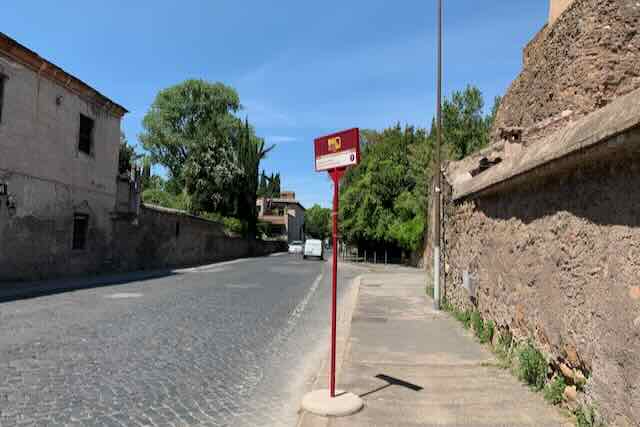 One of the conveniently located bus stops for the hop-on, hop-off bus tours near the Appian Way catacombs
One of the conveniently located bus stops for the hop-on, hop-off bus tours near the Appian Way catacombsOne nice way to visit the Appian Way catacombs is to go by bike - you can rent bicycles in the area and cycle in the Caffarella Park nearby.
Here's how to get to the main Rome catacombs:
Appia Antica Catacombs
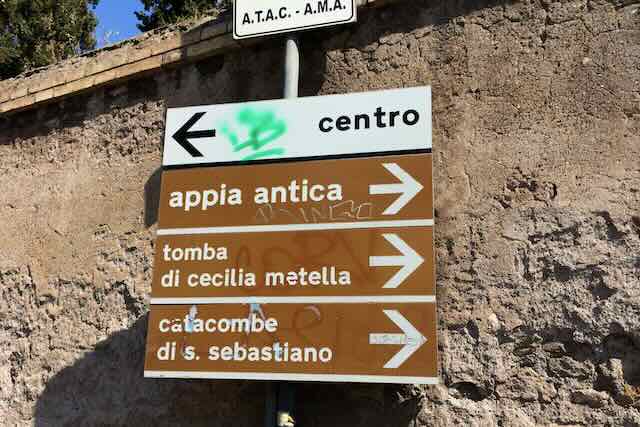 Visiting the catacombs on the Appian Way is probably the easiest option - especially as three of the best-known options are all pretty close to each other
Visiting the catacombs on the Appian Way is probably the easiest option - especially as three of the best-known options are all pretty close to each otherThree of Rome's best-known catacombs are near each other, on or near the Appian Way in the southern part of Rome.
- Catacombs of San Callisto (Via Appia Antica, 110/126) - The 118 bus drops you about 2 minutes' walk from the entrance. The 218 bus drops you about 5 minutes' walk from the entrance.
- Catacombs of San Sebastiano (Via Appia Antica, 136) - The 118 bus stops almost in front of these catacombs. The 218 bus stops at Fosse Ardeatine which is about a 10 minute walk to these catacombs.
- Catacombs of Santa Domitilla (Via delle Sette Chiese, 282) - These are also along the Via Appia Antica but in a different spot from the above two. The 714 bus and the 30 express bus both stop at Navigatori, about 9 minutes from here. The 218 bus stops at Fosse Ardeatine which is about a 5 minute walk away.
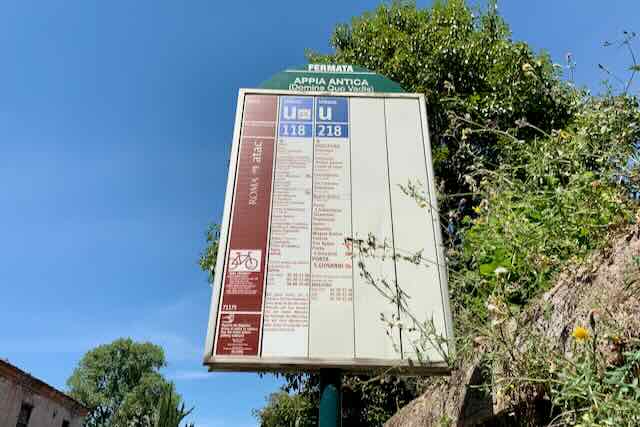 Rome's bus stops usually come with clear information about the specific buses that stop there, the routes they take and the bus schedule
Rome's bus stops usually come with clear information about the specific buses that stop there, the routes they take and the bus scheduleCatacombs in northern Rome:
- Santa Priscilla (Via Salaria, 430) - The 92 bus and the 310 bus each stop a few minutes from the entrance.
- Sant'Agnese (Via Nomentana, 349) - Being on a very busy road, there are many city buses that stop just outside the entrance to this site.
Disclosure: If you make a purchase through a link on this page, I may receive a small commission - at no extra cost to you. Thank you for supporting my site!
Catacombs in eastern Rome
- Saints Marcellinus and Peter (Via Casilina, 641) - The tram Giardinetti stops right in front, as does the 105 bus.
What will you see in the catacombs of Rome?
While all the catacombs in Rome were the burial place for ancient Romans, they all have different things for you to see.
Some, such as the Catacombs of San Callisto were home to the final resting place of prominent individuals - these catacombs are nicknamed “the little Vatican”, because 9 popes were buried here.
Even more impressive examples of important figures are at the Catacombs of San Sebastiano, which is where St Paul and Peter were both initially buried.
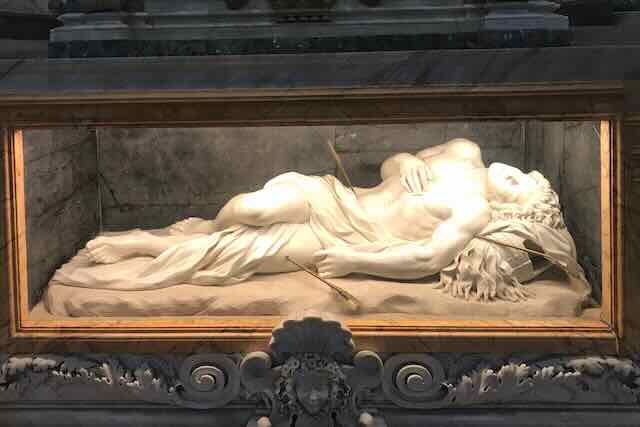 The catacombs aren't just underground sites, there's also stunning sculpture and architecture on show
The catacombs aren't just underground sites, there's also stunning sculpture and architecture on showThe Catacomb of Santa Domitilla is the only location you can visit that still has human remains.
It also has a 4th century basilica inside where you can worship, with vividly restored frescoes.
The Catacomb of Santa Priscilla is inside a monastery.
You will see stunning intact frescoes, including the earliest known depiction of Mary with the baby Jesus, and because there were so many martyrs and popes buried here, they're nicknamed the regina catacumbarum, the queen of the catacombs.
The catacombs of Sant'Agnese are under the basilica of the same name, and next to the Mausoleum of Santa Costanza.
It's worth taking a tour of the entire complex.
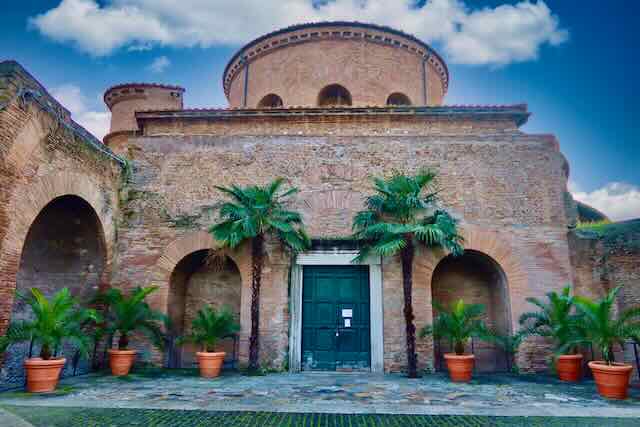 The Mausoleum of Santa Costanza is worth a visit in it's own right, why not combine this with a tour of the Sant'Agnese catacombs below!
The Mausoleum of Santa Costanza is worth a visit in it's own right, why not combine this with a tour of the Sant'Agnese catacombs below!The catacombs of Saints Marcellinus and Peter are under the Mausoleum of Saint Helen, today a museum.
Is it worth visiting the Rome catacombs?
They definitely are worth visiting for these reasons:
- If you're interested in Ancient Rome, this is a great way to learn about how the Romans handled death and burial, and how early Christians celebrated their dead.
- The catacombs are usually not on people's bucket lists so tend to be less crowded than the "must-see" attractions in Rome.
- If you're interested in art, this is the perfect way to learn about early fresco art techniques and themes.
- Visiting the catacombs and other underground sites can be a nice way to cool down in summer. The exception is Saint Peter's tomb (not a catacomb), which is actually hotter than above ground, and is best visited from fall through spring, and avoided in summer if possible.
If you had to pick one, which is the best catacomb in Rome?
Many people would say that the catacombs of San Callisto are the best catacombs to visit in Rome.
They are the largest and most well-known.
My favorite is the catacomb of Priscilla, not only for its beautiful frescoes, but also because it is lesser known, and therefore not as crowded as some of the others.
No matter which catacombs you visit, you are sure to have an interesting and educational experience.
For more information, visit the website of the commission responsible for the catacombs for opening hours, catacombs Rome map and more.
Romewise's Top Travel Resources
Ready to book your trip to Rome? Take a look at these helpful links to companies we use and trust:
- Keep your travel spending simple with the Wise card, which removes all the worry about exchange rates and high transaction fees all over the world
- Search for and book your perfect accommodation
- Our complete guide to what to pack for Rome
- The number one travel accessory, a multi-point travel adapter and voltage converter
- Browse a huge range of tours in Rome and beyond
- Experience unique tours and special access to Rome's most popular sights
- Protect yourself with comprehensive travel insurance
Within this post there are some affiliate links for products and services. For more details about our affiliate policy click here.
Get your 100% free Rome trip planner now!
Simply sign-up today for our free newsletter and get the Romewise Quick Start guide to Rome:
We are committed to respecting your data. Click for our Privacy Policy.
Comments? Questions? Suggestions?
Please come over to the private Romewise Facebook group and join in the conversation.
You will often find me there, happy to answer your questions / comments!
You will also meet other Rome lovers and experts, too.
What are you waiting for?
- Romewise Home Page
- What to Do in Rome
- Romantic Things to Do in Rome
- catacombs of Rome

